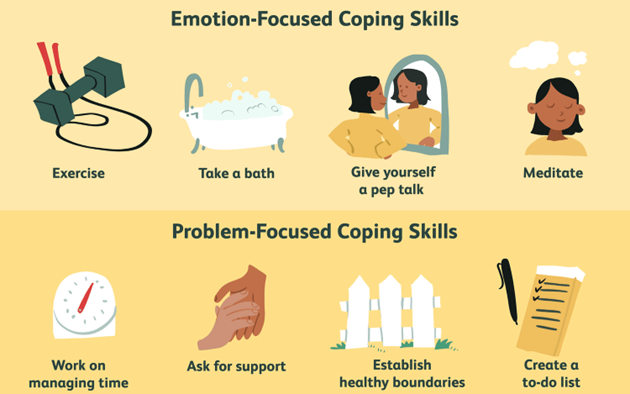A client with depression does not want to communicate with friends, uses television watching as a means of escaping responsibilities, and describes the inability to handle personal circumstances. Which coping strategy should the nurse include in the plan of care?

Concentrate on and ventilate emotions when distressed.
Shift attention from self to the needs and requests of others.
Relax and reduce the amount of effort to solve the problem.
Focus on small achievable tasks, not taxing problems.
The Correct Answer is D
Choice A Rationale:
While emotional expression and ventilation can be therapeutic, it may not be the most appropriate coping strategy for someone with depression who may already be overwhelmed by negative emotions. Ventilating emotions without a structured approach might not provide the desired relief and can even exacerbate feelings of distress.
Choice B Rationale:
This choice may not be suitable for someone with depression because it could lead to further neglect of their own needs and contribute to feelings of guilt or exhaustion.
Choice C Rationale:
While relaxation techniques can be helpful, reducing the effort to solve problems may not be the most effective strategy for individuals with depression. Avoidance of problems can perpetuate feelings of helplessness and hopelessness.
Choice D Rationale:
For a client with depression who is struggling with handling personal circumstances, focusing on small achievable tasks can be a helpful coping strategy. Breaking down larger problems into manageable steps can reduce feelings of overwhelm and gradually improve the client's sense of accomplishment and self-efficacy.
Nursing Test Bank
Naxlex Comprehensive Predictor Exams
Related Questions
Correct Answer is A
Explanation
Choice A rationale:
Encouraging the mother to write her thoughts and feelings in a journal is a constructive and therapeutic response. It provides an outlet for the mother to express her emotions and can be a helpful tool for coping with the challenges she is facing.
Choice B rationale:
Determining if the mother has other children who do not have developmental disabilities may be relevant to understanding her support system and family dynamics, but it does not directly address her current emotional distress.
Choice C rationale:
Reassuring the mother that her child will achieve some growth and development milestones may not be appropriate in this situation, as the child's disabilities are described as profound, and it is uncertain what milestones the child will reach. Providing false hope may not be helpful and could be misleading.
Choice D rationale:
Asking the mother if she has ever thought about harming herself or her child is an important inquiry related to her emotional state and the potential risk of harm. However, it should follow the initial response of encouraging her to express her thoughts and feelings in a journal.
Correct Answer is ["B","C","D"]
Explanation
Choice A rationale:
Clonazepam is not typically associated with a significant risk of causing urinary retention or frequent bathroom needs. There's no immediate need for bathroom assistance related to clonazepam use.
Choice B rationale:
Clonazepam is a medication that affects the central nervous system and can influence mental status. Regular assessment helps monitor for any changes or adverse effects.
Choice C rationale:
Clonazepam is administered orally, and it's important to ensure the client's oral health and comfort, especially since dry mouth can be a side effect.
Choice D rationale:
Clonazepam can cause drowsiness and potential changes in blood pressure, which could lead to orthostatic hypotension. Screening for this condition helps ensure the client's safety when changing positions.
Choice E rationale:
Clonazepam does not typically affect calcium levels. Monitoring calcium levels is not a standard nursing intervention when starting clonazepam.
Choice F rationale:
Clonazepam is not an opioid, and it does not require having an opioid agonist at the bedside. This intervention is not relevant to clonazepam use.
Whether you are a student looking to ace your exams or a practicing nurse seeking to enhance your expertise , our nursing education contents will empower you with the confidence and competence to make a difference in the lives of patients and become a respected leader in the healthcare field.
Visit Naxlex, invest in your future and unlock endless possibilities with our unparalleled nursing education contents today
Report Wrong Answer on the Current Question
Do you disagree with the answer? If yes, what is your expected answer? Explain.
Kindly be descriptive with the issue you are facing.
